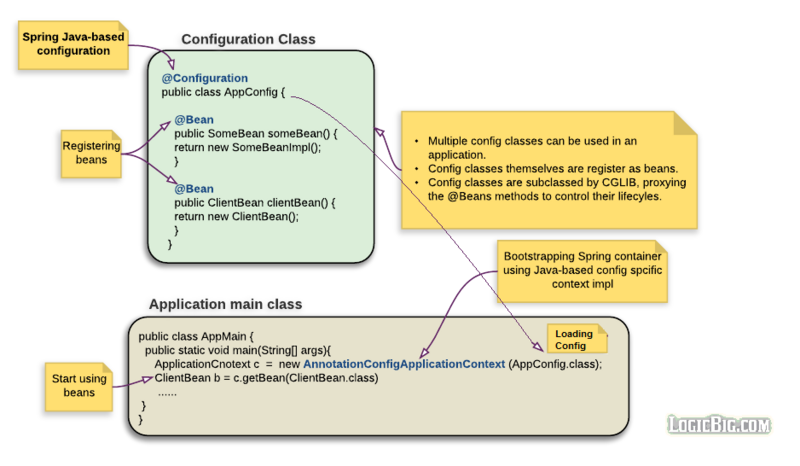Spring - Java-based configuration: Using @Configuration
@Configuration
这是一个类级注解。如下所示,被它注解的类可能包含多个被 @Bean 注解的方法。Spring容器会调用这些方法,获得你初始化后的对象实例,并把他们注册为容器内的beans。
package spring.example
@Configuration
public class MyAppConfig {
@bean
public SomeBean someBean() {
// 实例化并返回,也可进行初始化
return new SomeBeanImpl();
}
}
同等作用的XML配置会像下面这样:
<bean name="someBean" class="spring.example.SomeBeanImpl"/>

@Configuration 类们实际上就是Spring管理的用于创建并注册bean实例的工厂。
Spring容器的启动
在Java-based的配置方式下,spring容器可以被 AnnotationConfigApplicationContext 启动,或者,针对Web应用 AnnotationConfigWebApplicationContext 也行。
new AnnotationConfigApplicationContext(MyAppConfig.class);
我们也可以指定包含了 @Configuration 类的有效包名:
new AnnotationConfigApplicationContext("spring.example");
基于上述两个重载方法,我们可以在单个package下放进多个JavaConfig类。
使用多个JavaConfig类
new AnnotationConfigApplicationContext( AppConfig.class, DataSourceConfig.class );
new AnnotationConfigApplicationContext("example.spring.app","example.spring.datasource");
配置类中的依赖注入
既然配置类会被Spring容器注册成beans,那意味着,我们可以像使用普通bean那样使用这个配置bean。在以下例子我们要把这个一个配置bean注入给另一个配置bean:
@Configuration
public class AppConfig {
// 方式一:注入DataSourceConfig
@Autowired
private DataSourceConfig dataSourceConfig;
@Bean
Client clientBean() {
return new Client(dataSourceConfig.dataSourceBean());
}
public static void main(String[] args) {
AnnotationConfigApplicationContext context =
new AnnotationConfigApplicationContext(AppConfig.class, DataSourceConfig.class);
context.getBean(Client.class).showData();
}
// 方式二:为何要那么麻烦呢?直接注入DataSourceBean不就好了?
@Autowired
private DataSourceBean dataSourceBean;
@Bean
Client clientBean() {
return new Client(dataSourceBean);
}
}
@Configuration
class DataSourceConfig {
@Bean
DataSourceBean dataSourceBean() {
return new DataSourceBean();
}
}
class Client {
private DataSourceBean dataSourceBean;
Client(DataSourceBean dataSourceBean){
this.dataSourceBean = dataSourceBean;
}
public void showData() {
System.out.println(dataSourceBean.getData());
}
}
class DataSourceBean {
public String getData() {
return "some data";
}
}
正文到此结束
热门推荐
相关文章
Loading...











![[HBLOG]公众号](https://www.liuhaihua.cn/img/qrcode_gzh.jpg)

